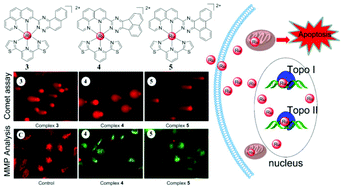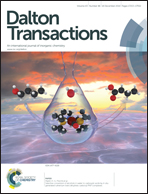Dual inhibition of topoisomerases I and IIα by ruthenium(ii) complexes containing asymmetric tridentate ligands†
Abstract
Five novel ruthenium(II) complexes, [Ru(dtzp)(dppt)]2+ (1), [Ru(dtzp)(pti)]2+ (2), [Ru(dtzp)(ptn)]2+ (3), [Ru(dtzp)(pta)]2+ (4) and [Ru(dtzp)(ptp)]2+ (5) (where dtzp = 2,6-di(thiazol-2-yl)pyridine, dppt = 3-(1,10-phenanthroline-2-yl)-5,6-diphenyl-as-triazine), pti = 3-(1,10-phenanthroline-2-yl)-as-triazino-[5,6-f]isatin, ptn = 3-(1,10-phenanthroline-2-yl)-as-triazino[5,6-f]naphthalene, pta = 3-(1,10-phenanthroline-2-yl)-as-triazino[5,6-f]acenaphthylene, and ptp = 3-(1,10-phenanthroline-2-yl)-as-triazino[5,6-f]-phenanthrene), were synthesised and characterised. The structures of complexes 3–5 were determined by X-ray diffraction. The DNA binding behaviours of the complexes were studied by spectroscopic and viscosity measurements. The results suggested that the Ru(II) complexes, except for complex 1, bind to DNA in an intercalative mode. Topoisomerase inhibition and DNA strand passage assay confirmed that Ru(II) complexes 3, 4, and 5 acted as efficient dual inhibitors of topoisomerases I and IIα. In vitro cytotoxicity assays indicated that these complexes exhibited anticancer activity against various cancer cell lines. Ruthenium(II) complexes were confirmed to preferentially accumulate in the nucleus of cancer cells and induced DNA damage. Flow cytometric analysis and AO/EB staining assays indicated that these complexes induced cell apoptosis. With the loss of the mitochondrial membrane potential, the Ru(II) complexes induce apoptosis via the mitochondrial pathway.


 Please wait while we load your content...
Please wait while we load your content...